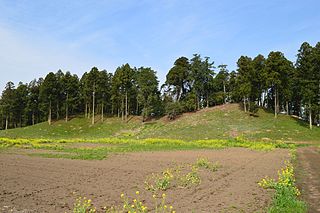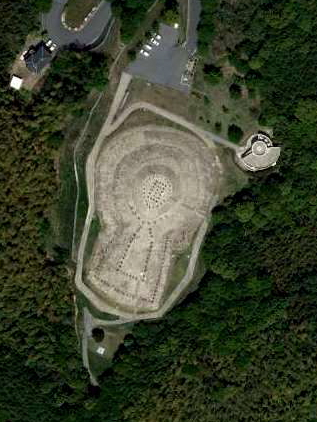
Nishizuka Kofun is a kofun burial mound located in what is now part of the town of Wakasa, Fukui in the Hokuriku region of Japan. The site was designated a National Historic Site of Japan in 1935.

Atagozuka Kofun (愛宕塚古墳) is a Kofun period burial mound located in the town of Mibu, Shimotsuga District, Tochigi Prefecture in the northern Kantō region of Japan. It received protection as a National Historic Site in 1926.

The Ushizuka Kofun (牛塚古墳) is a scallop-shaped Kofun period burial mound located in the town of Mibu, Shimotsuga District, Tochigi Prefecture in the northern Kantō region of Japan. It received protection as a National Historic Site in 1926.

The Azuma Kofun (吾妻古墳) is a Kofun period burial mound located on the border of the town of Mibu, Shimotsuga District, and the city of Tochigi in Tochigi Prefecture in the northern Kantō region of Japan. It received protection as a National Historic Site in 1970.

Kurumazuka Kofun (車塚古墳) is a Kofun period burial mound located in the town of Mibu, Shimotsuga District, Tochigi Prefecture in the northern Kantō region of Japan. It received protection as a National Historic Site in 1926.

The Marishitenzuka Kofun (摩利支天塚古墳) is a Kofun period burial mound located in the Iizuka neighborhood of the city of Oyama in Tochigi Prefecture in the northern Kantō region of Japan. It received protection as a National Historic Site in 1978. It is the third largest in the prefecture.

The Biwazuka Kofun (琵琶塚古墳) is a Kofun period burial mound located in Iizuka neighborhood of the city of Oyama in Tochigi Prefecture in the northern Kantō region of Japan. The tumulus received protection as a National Historic Site in 1926. It is the second largest in the prefecture.

The Ushiro-Futago Kofun (後二子古墳) is a Kofun period burial mound located in the Nishiomuromachi neighborhood of the city of Maebachi, Gunma Prefecture in the northern Kantō region of Japan. Together with the Sho-Futago Kofun (小二子古墳), it was designated a National Historic Site of Japan in 1927. The site dates from the late 6th century AD, and these tumuli are two of the five in the Ōmuro kofun cluster. The area is now preserved as a park.

The Hodota Kofun Cluster (保渡田古墳群) is a group of three Kofun period burial mounds located in what is now the city of Takasaki, Gunma Prefecture in the northern Kantō region of Japan. It was designated a National Historic Site of Japan in 1985.

The Omishinkanji Kofun (小見真観寺古墳) is a Kofun period burial mound located in the Omi neighborhood of the city of Gyōda, Saitama Prefecture in the Kantō region of Japan. It was designated a National Historic Site of Japan in 1931.

The Nagae-Sakurayama Kofun cluster is a pair of Kofun period burial mound located on the border of the city of Zushi and town of Hayama, Kanagawa Prefecture in the southern Kantō region of Japan. The pair were designated a National Historic Site in 2002. It is the only known keyhole-shaped tumuli in the Miura Peninsula, and the largest in Kanagawa Prefecture.

Imashirozuka Kofun (今城塚古墳) is a Kofun period keyhole-shaped burial mound, located in the Gungeshinmachi neighborhood of the city of Takatsuki, Osaka in the Kinai region of Japan. The tumulus was designated a National Historic Site of Japan in 1958, with the area under protection expanded in 2006. It is the largest kofun in the Yodo River basin and one of the largest constructed in the first half of the sixth century. Although it has not been sanctioned by the Imperial Household Agency, there is a credible theory that it is the true tomb of the 26th Emperor Keitai.

The Akeae Kofun (明合古墳) is a kofun burial mound located in the Ano neighborhood of the city of Tsu, Mie Prefecture in the Kansai region of Japan. It was designated a National Historic Site of Japan in 1952.

The Kōjinyama Kofun (荒神山古墳) is a Kofun period burial mound located between the Hinatsu and Kiyosaki neighborhoods of the city of Hikone Shiga Prefecture in the Kansai region of Japan. The tumulus was designated a National Historic Site of Japan in 2011.

The Chausuyama Kofun (茶臼山古墳) is a Kofun period burial mound located in the Akibadai neighborhood of Ōtsu, Shiga in the Kansai region of Japan. The tumulus was designated a National Historic Site of Japan in 1921. With a total length of 122 meters, it is the third largest kofun in Shiga Prefecture.

The Goshikizuka Kofun (五色塚古墳) is a kofun burial mound located in the Goshikiyama neighborhood of Tarumi-ku, Kobe, Hyōgo Prefecture, in the Kansai region of Japan. The tumulus is the largest in Hyōgo Prefecture, and is estimated to have been built around the end of the 4th century and the beginning of the 5th century. It is known as the first kofun to be restored to what archaeologists believe to be its original appearance. It is also known as the Sentsubo Kofun (千壺古墳). Together with the smaller neighboring Kotsubo Kofun (小壺古墳) it was designated a National Historic Site in 1921, with the area under protection extended in 1974, 1979 and 2006.

The Tomita Chausuyama Kofun (富田茶臼山古墳) is a kofun burial mound located in the Ōkawamachi Tomidanaka neighborhood of the city of Sanuki, Kagawa Prefecture, on the island of Shikoku of Japan. The tumulus was designated a National Historic Site in 1993. It is the largest burial mound in the Shikoku region, and is estimated to have been built around the middle of the 5th century.

Ryōgūzan Kofun (両宮山古墳) is a Kofun period burial mound, located in the city of Awaiwa, Okayama Prefecture, in the San'in region of Japan. The tumulus was designated a National Historic Site of Japan in 1924 with the area under protection expanded in 1978 and again in 2006. It is largest keyhole-shaped burial mound in the Bizen region and the third largest in Okayama Prefecture, and the 39th largest in Japan.

Urama Chausuyama Kofun (浦間茶臼山古墳) is a Kofun period burial mound located in the Urama neighborhood of Higashi-ku, Okayama, Okayama Prefecture, in the San'yō region of Japan. The tumulus was designated a National Historic Site of Japan in 1974. It is believed to have been built at the end of the 3rd century in the early Kofun period. It is one of the oldest large keyhole-shaped burial mounds in ancient Kingdom of Kibi.

Yanai Chausuyama Kofun (柳井茶臼山古墳) is a Kofun period keyhole-shaped burial mound, located in the Yanai neighborhood of the city of Yanai, Yamaguchi in the San'yo region of Japan. The tumulus was designated a National Historic Site of Japan in 1948.





















